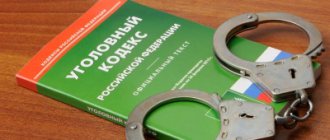ST 326 of the Criminal Code of the Russian Federation.
1. Forgery or destruction of identification number, body number, chassis, engine, as well as forgery of the state registration plate of a vehicle for the purpose of operating or selling a vehicle, use of a knowingly counterfeit or counterfeit state registration plate for the purpose of committing a crime or facilitating its commission or concealment, as well as the sale of a vehicle with a knowingly counterfeit identification number, the number of the body, chassis, engine or with a knowingly counterfeit state registration plate, or the sale of a body, chassis, or engine with a knowingly counterfeit number - is punishable by a fine in the amount of up to eighty thousand rubles or in the amount of wages or other income of the convicted person for a period of up to six months, or compulsory work for a term of up to three hundred sixty hours, or correctional labor for a term of up to one year, or restriction of liberty for a term of up to two years, or forced labor for a term of up to two years, or imprisonment for a term of up to two years the same period.
2. The same acts committed by a group of persons by prior conspiracy or by an organized group are punishable by compulsory labor for a term of up to four hundred eighty hours, or correctional labor for a term of up to two years, or restriction of freedom for a term of up to three years, or forced labor for a term of up to three years, or imprisonment for the same period.
Commentary to Art. 326 Criminal Code
1. Subject of the crime: a) genuine or fake vehicle identification number; b) genuine or fake body, chassis, engine numbers. Genuine numbers are assigned to the vehicle, its structural parts and assemblies by the manufacturer; c) a fake state registration plate that replaces a genuine sign - a number issued by the State Traffic Safety Inspectorate (see commentary to Article 325.1 of the Criminal Code).
2. The objective side is characterized by the commission of one or more of the actions specified in the law with the relevant objects.
Forgery of an identification number, number of parts and assemblies of a vehicle, state registration plate - changing them by etching, interrupting or other means, or applying (manufacturing) a completely fictitious number (sign).
Destruction of the identification number, number of parts and assemblies of a vehicle means their irreversible complete destruction.
The use of a fake registration plate consists of placing it on the vehicle body in place of the original one.
The sale of a vehicle with a fake identification number or the number of parts and assemblies, with a fake state registration plate, or the sale of a body, chassis, or engine with a fake number constitutes their sale or other final alienation, not necessarily of a compensated nature.
Actions included in the objective side, in particular the destruction of original license plates or signs that ensured the correct identification of the vehicle, its components and assemblies, may entail consequences, but the crime has a formal composition, and therefore ends at the time of the commission of these actions.
3. Qualification of individual actions involves the establishment of special purposes for their implementation: a) operation or sale of a vehicle (in case of falsification or destruction of the identification number, body number, chassis number, engine number, as well as forgery of the state registration plate of the vehicle); b) committing a crime or facilitating its commission or concealment (using a counterfeit or counterfeit state registration plate).
Methods of changing car license plates used by car thieves
Each car is assigned an identification number. It is designated as VIN and is indicated after the body is released from production:
Using the VIN code, you can find out the history of the vehicle. The Criminal Code of the Russian Federation prohibits arbitrarily deleting an identification code.
Hijackers have developed a whole system for replacing signs. Clandestine auto repair shops offer their services for changing license plates on a car; the cost of manipulation varies depending on the complexity of the work.
Replacing characters with similar letters or numbers
People try to change the car body number not only when the car is stolen, but also after the vehicle is involved in an accident. You can cut off the plates from the dashboard and engine surfaces. And this will not be noticeable at first glance. Interruption of car body numbers is determined only after detailed diagnostics.
The number "7" is made from the letter "Z"
One option is to work with similar letters and numbers. It is quite simple to change the car body number using this method. For example, the letter “Z” is transformed into the number “3”. For work, paints and varnishes are used, the identification plate is additionally heated. These techniques allow you to change the number on the car body without the use of welding or metal cutting.
Second commentary to Art. 326 of the Criminal Code of the Russian Federation
1. The subject of this crime includes: identification number of the vehicle, number of the body, chassis, engine (indicated in the state registration certificate and technical passport of the vehicle); state registration plate of the vehicle.
2. Part 1 provides for liability for three acts that differ in the characteristics of the subject, objective and subjective aspects.
3. Forgery of identification number, body number, chassis number, engine number, state registration plate (Part 1 of Article 326 of the Criminal Code) - complete or partial change of individual digital or letter designations of the number. The destruction of the specified item is its liquidation.
4. The subjective side of this crime includes, in addition to direct intent, alternative goals: to commit a crime or facilitate its commission or conceal it.
5. Use of a knowingly counterfeit or forged state registration plate (see: commentary on Article 325.1 of the Criminal Code).
6. The subjective side of this act: the direct intent and purpose of committing a crime, concealing a crime or facilitating the commission of a crime.
7. Sales of a vehicle with obviously counterfeit license plates (identification number, body number, chassis number, engine number, state registration plate). Sales of body, chassis, engine with a deliberately fake number. Sales means release into circulation (permanent or temporary use). Sale is not only sale or donation, but also provision for use by proxy.
8. Subjective side - direct intent.
9. The subject of all listed crimes is a person who has reached the age of 16 years.
10. A qualifying feature is the commission of a crime by a group of persons by prior conspiracy or by an organized group (see: commentary on Article 35 of the Criminal Code of Russia).
Article of the Criminal Code of the Russian Federation for interrupting car body numbers, how car thieves interrupt license plates
According to the article, breaking signs on a car will be considered a planned act if the perpetrator understood what he was doing and changed the VIN for the purpose of his own enrichment. Judicial practice shows that violation entails imprisonment for up to 3 years.
When purchasing a car secondhand, it is easy to become the owner of one that has been stolen. Fraudsters change vehicle license plates in order to legalize a stolen vehicle in any way possible.
How to identify broken numbers on a car body
Car thieves are trying to quickly sell a stolen car with an altered VIN. There are several simple ways to help determine that a car’s body number has been changed:
An unscrupulous seller can be reminded that there is an article of the Criminal Code of the Russian Federation for interrupting car body numbers. Perhaps this will stop you from selling a car with a dubious reputation in the future.
Those who buy a car at a dealership have the opportunity to request a description of the equipment and VIN specifications. This service may be provided additionally to protect the client and maintain the salon’s reputation.
Source
Alien signs
A counterfeit of a registration plate is its production in violation of the procedure established by the legislation on technical regulation or the introduction of changes to the sign that distort the symbols printed on it, for example, by using tint, allowing it to be read differently.
The use of a knowingly false registration plate includes, in particular, the installation on a vehicle for the purpose of committing a crime or facilitating its commission or concealing a registration plate manufactured in the prescribed manner, but different from that included in the registration documents. For example, the sign was issued for another car.
Let us recall that earlier the Plenum of the Supreme Court gave exactly the same explanation of what is considered a counterfeit registration mark for administrative proceedings. Previously, there was a practice when people themselves tinted numbers worn out by time so that they could be read. And then they were accused of forging signs. But the reading of the number did not change as a result of the coloring. This means that no one faked the number. And there is no reason to bring the motorist to administrative or criminal liability.
It is noteworthy that the Criminal Code makes no difference in the use of counterfeit or forged signs. For any of these acts, the responsibility is the same: from a fine of 80 thousand rubles to 2 years in prison.
However, there is a significant difference for forged or counterfeit documents. Forgery of documents is punishable by imprisonment for up to two years. An official document can be forged. Official documents include those that can entail legal consequences in the form of the granting or deprivation of rights, the imposition of obligations or exemption from them, changes in the scope of rights and obligations. For example, a driver's medical certificate gives a person the right to take an exam and obtain a driver's license.
Forgery is recognized as the illegal alteration of individual parts of an original official document by erasure or addition, distorting its actual content, and the production of a new official document containing deliberately false information, including the use of genuine forms, seals and stamps.
The use of an authentic document that has expired does not constitute a crime.
Chairman of the Board of the Association of Lawyers of Russia Vladimir Gruzdev explained that the resolution of the plenum of the Supreme Court of Russia contains other important clarifications concerning various aspects of crimes that are in one way or another connected with false documents. For example, it clarifies what can be considered important documents.
Another important clarification relates to what counts as official documents. The Criminal Code establishes liability for the acquisition and sale of official documents, as well as theft or damage to documents. Official documents also include electronic documents.
Source
The Supreme Court plenum dealt with fake documents and license plates
The plenum of the Supreme Court of the Russian Federation discussed a draft resolution on cases of crimes encroaching on the established procedure for the circulation of official documents, state awards, excise stamps, as well as the procedure for recording vehicles. It turned out that judicial practice is very contradictory. And recent changes to criminal legislation have only added problems to law enforcement officers.
Lack of clarity and uniform approach
The speaker, Judge of the Supreme Court of the Russian Federation Tatyana Ermolaeva, recalled that in 2019 the legislator made significant changes to Article 327 of the Criminal Code of the Russian Federation, aimed at strengthening liability for forgery, production or circulation of counterfeit documents, state awards, stamps, seals or forms. In addition, Article 327.1 of the Criminal Code of the Russian Federation (production, sale of counterfeit excise stamps, special stamps or marks of conformity) has been repeatedly edited to make it stricter.
“These changes, not consistent in all respects, but contradictory in a number of ways, have brought a number of problems to judicial practice in criminal cases of such crimes,” advised the judge of the Supreme Court of the Russian Federation.
Ermolaeva provided general statistics. About 11-12 thousand people are convicted annually for committing crimes under Articles 324–327.1 of the Criminal Code of the Russian Federation. At the same time, criminal cases against a quarter of the accused were dismissed by the courts on non-exonerating grounds. Including the imposition of a court fine. The vast majority of persons (about 95%) are prosecuted under Article 327 of the Criminal Code.
“The study of judicial practice revealed a lack of clarity and a uniform approach among the courts on a number of issues regarding the application of this article,” said the judge of the Supreme Court.
First of all, according to Ermolaeva, difficulties are associated with the lack of legislative definitions of the concepts of “official document”, “official document granting rights or relieving oneself from obligations”, as well as “important personal document”. Despite the fact that for the purposes of criminal law relations it is difficult and sometimes incorrect to use the interpretation of documents contained in other branches of law. The Constitutional Court of the Russian Federation drew attention to this circumstance in its ruling dated May 19, 2009. Also, the legislator has not proposed clear distinctions between the criteria for different types of documents. And his approach to establishing crime and the punishability of unlawful acts with these documents is not entirely consistent.
Ermolaeva gave an example. Thus, according to Article 325 of the Criminal Code of the Russian Federation, liability for the theft of a citizen’s passport is less strict than for similar actions in relation to other official documents. And according to Article 327 of the Criminal Code of the Russian Federation, on the contrary, forgery of a passport and its use entail a more severe punishment than forgery of an official document granting rights or releasing one from obligations.
How to differentiate between documents
Ermolaeva gave a brief overview of the contents of the draft resolution, consisting of 19 points. The Supreme Court judge called the document “quite laconic,” but at the same time one that comprehensively includes an explanation of only those issues that concern the law enforcement officer.
Paragraphs 1–4 discuss the subject of crimes provided for in Articles 324, 325 and 327 of the Criminal Code of the Russian Federation. These points, according to Ermolaeva, contain the answer to the main question: what is meant by specific types of documents and how to distinguish them from each other.
In paragraph 1, taking into account the established judicial practice, it is explained that official documents granting rights or releasing from obligations in Article 324 of the Criminal Code of the Russian Federation and official documents in Part 1 of Article 325 of the Criminal Code of the Russian Federation mean such documents, including electronic ones, that are created and issued or are certified in the manner prescribed by law or other regulatory act by federal government bodies, government bodies of constituent entities of the Russian Federation, local government bodies or authorized organizations or persons. And the main purpose of these documents is that they certify legally significant facts.
Such documents fully include electronic documents. Recognition of the materiality of an electronic document as a type of document and its equivalence to a document on paper follows from the provisions of the federal laws on information and on electronic signatures.
“In the context of the development of digital technologies and the increasing use of electronic document management, unlawful actions in relation to electronic documents that are official can be qualified under Articles 324 and 325 of the Criminal Code of the Russian Federation, and their forgery - under Article 327 of the Criminal Code of the Russian Federation,” Ermolaeva explained.









